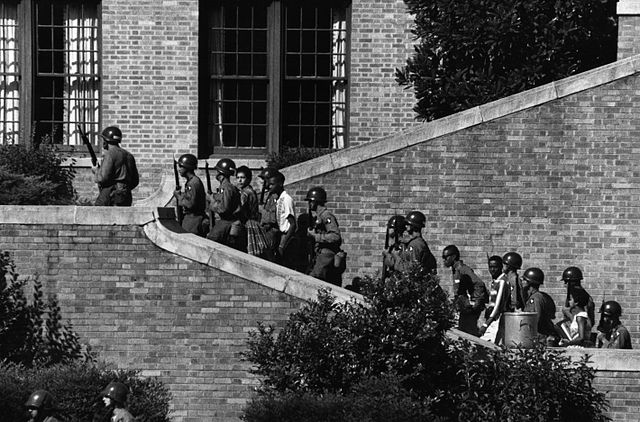*Image Credit: Wikipedia In the wake of the Brown v. Board of Education decision rendered by the Supreme Court in 1954, the United States had legally abolished the practice of setting up segregated schools for white and black children. By making the racially-motivated program — a holdover from the years after the Civil War — unconstitutional, the Court insisted that every public academic center in the country could no longer deny admission on the basis of race. The Little Rock Nine, a group of black students set to attend Little Rock Central High School in the capital of Arkansas, finally made it to class on September 24, 1957 when President Dwight D. Eisenhower sent the Army’s 101st Airborne Division to provide support. Heavily resistant to the idea of making changes, many states that fought on the side of the Confederacy during the Civil War immediately posed objections based on overreach by the Court and, by extension, the federal government as a whole. Though not the only region of the United States in which such segregation occurred, the South was more vocal in its disdain for the ruling. Despite the likelihood of uproar to come, the Little Rock School Board agreed to a policy laid out by Superintendent Virgil Blossom for the 1957-58 school year to be the start of compliance with the new law. When the fall of 1957 arrived, residents of Little Rock vowed to block the entry of the students in question — Ernest Green, Elizabeth Eckford, Jefferson Thomas, Terrence Roberts, Carlotta Walls, Minnijean Brown, Gloria Ray, Thelma Mothershed and Melba Pattillo. Offering support to the protesters, Governor Orval Faubus arranged to have the Arkansas National Guard encircle the school, as well. Ranging in age from 14 to 16, the students were soon surrounded by an angry mob cursing and spitting at them — the scene, splashed across the pages of newspapers from coast to coast, caused a national uproar. Resolved to see the school integrated as directed by law, Eisenhower sent for Faubus and communicated his desire to see the a peaceful outcome to the proceedings. Stating in no uncertain terms the students would enter Central High, he watched the situation closely as the days dragged on. With no end in sight, Woodrow Nilson Mann, Little Rock’s mayor, pleaded with the President to send in federal troops. Reluctant to see such a display of force but willing to do whatever it took to uphold the law, Eisenhower ordered the US Army’s famed 101st Airborne Division to the city and federalized the National Guard — the Commander-in-Chief was now at the helm. On September 24, 1957, flanked by 11 paratroopers, the Little Rock Nine walked through the doors of Central High despite the shouts of an angry crowd outside. Though a small victory for those fighting for racial equality, the school year would be filled with battles for the students themselves. Instructed not to reply to the harsh treatment they would face by members of the National Association for the Advancement of Colored People and other black leadership groups, the hostility aimed at the young men and women by their white counterparts would turn out, in some instances, to be barbaric. (Patillo would later report acid being thrown at her, as well as an attempt by other girls to barricade her in a bathroom stall and throw burning paper over the top.) Of the nine who entered the classrooms at Central High on that fateful day, only three would complete their education at the school in Little Rock. Ernest Green would go on to graduate in 1958, becoming the first black student to earn his diploma from the integrated school, eventually becoming Assistant Secretary of Housing and Urban Affairs during Jimmy Carter’s presidency in the late 1970s. Also On This Day: 275 – The Roman Senate names a new Emperor, Marcus Claudius Tacitus. 1906 – Leonardo Torres Quevedo demonstrates the Telekino, the first known instance of remote control. 1956 – The first transatlantic telephone cable system (TAT-1) is put into service. 1962 – The People’s Republic of Algeria establishes a provisional government. 1981 – Sandra Day O’Connor becomes the first woman on the United States Supreme Court.
September 25, 1957 CE – The 101st Airborne Division Escorts the Little Rock Nine to School
*Image Credit: Wikipedia In the wake of the Brown v. Board of Education decision rendered by the Supreme Court in 1954, the United States had legally abolished the practice of…
449
